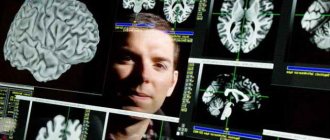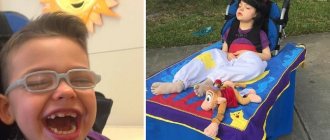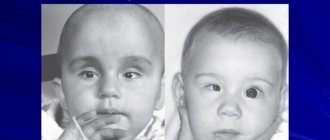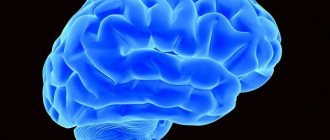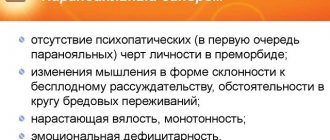Epileptic syndrome is a condition in which the convulsive state that usually occurs during epileptic seizures occurs frequently.
A seizure (the main symptom of the syndrome) usually begins suddenly, although the body warns of its occurrence with some symptoms: a day or two before the onset of a seizure, a severe or moderate headache may be observed, appetite disturbance occurs, sleep becomes restless, the person is overly irritable and complains of bad things. well-being. In some cases, the seizure begins with the appearance of an aura in the patient.
In medical practice, auras are divided into:
- motor : in this case, the patient’s seizure begins with the patient freezing in some position or starting to run somewhere;
- sensory : disturbances of the senses (visual, gustatory, olfactory);
- vegetative : discomfort in the heart, heat or cold in the head, urge to urinate, increased peristalsis;
- sensitive : paresthesia of different parts of the body is observed;
- vestibular;
- mental : an unreasonable feeling of fear, joy, euphoria.
The duration of the aura can last only a few seconds, after which the person loses consciousness, emitting a kind of cry, which is a consequence of a spasm of the vocal cords. For the next quarter of an hour, tonic convulsions occur. At this time, the patient’s breathing is delayed, the face becomes bluish-pale, the veins in the neck swell, and cyanosis increases.
For the next 3 minutes, clonic convulsions continue, during which hoarse, noisy breathing is observed. There is a variant of tongue retraction.
Cyanosis slowly recedes, saliva is released in the form of foam (it may turn red as a result of blood entering the saliva due to biting the tongue or the inside of the cheek).
During a seizure, the patient does not respond to external stimuli, dilated pupils do not respond to light, and tendon reflexes do not function. Sometimes the patient can fall asleep without leaving this state.
The entire attack lasts about 4 minutes and after it ends the person feels depressed, drowsy, and weak. The patient does not remember anything about the seizure itself.
Epileptic syndrome, unlike epilepsy, is the result of a previous disease (or accompanies it). Epilepsy is an independent disease, which most often has a congenital character. Also, the syndrome, despite the fact that the symptoms are similar to epilepsy, goes away a little easier.
Epileptic syndrome and epilepsy - what are the differences?
Lennox-Gastaut syndrome (LGS) is an epileptic encephalopathy of childhood, characterized by polymorphism of seizures, specific EEG changes and resistance to therapy.
The frequency of LGS is 3-5% among all epileptic syndromes in children and adolescents; Boys get sick more often. Infantile spasms are transformed into tonic seizures in the absence of a latent period and smoothly turn into LGS.
https://www.youtube.com/watch?v=ytadvertiseru
Infantile spasms disappear; the child’s psychomotor development improves somewhat; the EEG picture gradually normalizes. Then, after a certain latent period of time, which varies in different patients, attacks of sudden falls, atypical absences appear, and diffuse slow peak-wave activity on the EEG increases.
LSH is characterized by a triad of attacks: paroxysms of falls (atonic- and myoclonic-astatic); tonic seizures and atypical absence seizures. The most typical attacks are sudden falls caused by tonic, myoclonic or atonic (negative myoclonus) paroxysms. Consciousness can be maintained or switched off briefly. After the fall, no convulsions are observed, and the child gets up immediately. Frequent attacks of falls lead to severe trauma and disability of patients.
Tonic seizures can be axial, proximal or total; symmetrical or clearly lateralized. Attacks include sudden flexion of the neck and torso, raising the arms in a state of semiflexion or extension, straightening the legs, contraction of the facial muscles, rotational movements of the eyeballs, apnea, and facial flushing. They can occur both during the daytime and, especially often, at night.
Atypical absence seizures are also characteristic of LGS. Their manifestations are diverse. The impairment of consciousness is incomplete. Some degree of motor and speech activity may remain. Hypomimia and drooling are observed; myoclonus of the eyelids, mouth; atonic phenomena (the head falls on the chest, the mouth is slightly open). Atypical absence seizures are usually accompanied by a decrease in muscle tone, which causes the body to “go limp,” starting with the muscles of the face and neck.
The neurological status shows manifestations of pyramidal insufficiency and coordination disorders. A decrease in intelligence is characteristic, but does not reach a severe degree. Intellectual deficit is detected from an early age, preceding the disease (symptomatic forms) or develops immediately after the onset of attacks (cryptogenic forms).
An EEG study in a large percentage of cases reveals irregular diffuse, often with amplitude asymmetry, slow peak-wave activity with a frequency of 1.5-2.5 Hz during wakefulness and fast rhythmic discharges with a frequency of about 10 Hz during sleep.
Neuroimaging may reveal various structural abnormalities in the cerebral cortex, including developmental defects: hypoplasia of the corpus callosum, hemimegalencephaly, cortical dysplasia, etc.
Drugs that suppress cognitive function (barbiturates) should be avoided in the treatment of LPH. The most commonly used drugs for LSH are valproate, carbamazepine, benzodiazepines, and lamictal. Treatment begins with valproic acid derivatives, gradually increasing them to the maximum tolerated dose (70-100 mg/kg/day and above).
Carbamazepine is effective for tonic seizures - 15-30 mg/kg/day, but can increase absence seizures and myoclonic paroxysms. A number of patients respond to an increase in the dose of carbamazepine with a paradoxical increase in attacks. Benzodiazepines are effective for all types of seizures, but the effect is temporary.
In the group of benzodiazepines, clonazepam, clobazam (Frisium) and nitrazepam (radedorm) are used. For atypical absence seizures, suxilep may be effective (but not as monotherapy). The combination of valproate with lamictal (2-5 mg/kg/day and higher) has been shown to be highly effective. In the United States, the combination of valproate and felbamate (thalox) is widely used.
The prognosis for LGS is severe. Stable control of attacks is achieved only in 10-20% of patients. The predominance of myoclonic seizures and the absence of gross structural changes in the brain are prognostically favorable; negative factors are the dominance of tonic seizures and gross intellectual deficit.
https://www.youtube.com/watch?v=ytcopyrightru
These two concepts should be clearly distinguished. The main difference is the origin of these two conditions. SE develops due to some previous brain disease. Epilepsy is a separate disease, the causes of which are unknown.
Epilepsy is accompanied by frequent mental disorders. In sick patients, intelligence decreases, thought processes are disrupted, and mood swings occur frequently. In epileptic syndrome, such manifestations do not occur.
If the underlying brain disease that causes the development of epileptic syndrome is eliminated, all signs of this condition may disappear.
Thus, SE does not mean that the patient suffers from epilepsy.
If epileptic syndrome is not treated in a timely manner, serious complications may arise, which will lead to more frequent attacks and disruption of metabolic processes in the body.
Status epilepticus is characterized by a large number of seizures, during which the person may not even regain consciousness. If appropriate measures are not taken to eliminate the syndrome, the patient may enter a coma.
The development of status epilepticus is caused by insufficient drug therapy, previous infectious diseases, and traumatic brain injury. The condition may also worsen with frequent alcohol consumption.
The disease does not lead to disability. In this state, a person can lead a full life and work. At the same time, you should not forget about taking medications, monitor the development of the disease, and try to avoid exacerbations. If you notice that attacks begin to appear much more often and last longer, you should seek help from specialists.
The further prognosis of the development of the disease is determined by the timely elimination of the main cause of this disease.
There are infections that can be completely cured. In this case, the attacks disappear completely.
https://www.youtube.com/watch?v=ytdevru
Difficulties may arise from the consequences of injuries or congenital pathologies. Then longer treatment will be required, and then further rehabilitation.
Measures to prevent epileptic syndromes include the following:
- timely treatment of infectious diseases,
- rapid reduction of high temperature,
- try to avoid head injuries as much as possible,
- avoid sudden overheating or hypothermia of the body,
- if you suspect a brain tumor, seek advice and additional examination,
- Constant monitoring of blood pressure to prevent stroke.
Thus, epileptic syndrome is not a life sentence. If timely and correct treatment is started after the first attack occurs, further attacks can be avoided. If it is impossible to eliminate the cause of the seizures, the patient is required to take anti-seizure medications on an ongoing basis.
The inter-district department of paroxysmal conditions (epileptologist's office) receives patients at the clinic.
You can get detailed information about the work of the epileptologist’s office by phone (available from 8:00 to 15:00).
Episyndrome (pseudo-epilepsy) is sudden and recurring attacks of convulsions in a child, externally similar to epilepsy.
Episyndrome is always a consequence of some disease. The attacks stop as soon as the underlying cause of which they were a symptom is cured.
If for the development of an attack of true epilepsy an epileptic focus is needed (a group of brain cells with increased electrical activity), then with episyndrome there is no such focus, therefore, when examined on an electroencephalogram (EEG), it is not found.
The main cause of episyndrome is oxygen starvation of brain cells, as well as changes in their chemical state.
Such processes develop as a result of birth injuries of the cervical spine, causing a decrease in cerebral blood flow and an increase in intracranial pressure, as well as after various brain injuries (trauma, previous diseases, chemical poisoning).
The development of seizures occurs from irritation of the cerebral cortex or its deep structures and is accompanied by a flash of increased electrical activity of nerve cells (a kind of “short circuit” in the brain).
Quite often, the first attack of seizures in a child develops at elevated temperatures or after vaccination, since in such conditions intracranial pressure increases and oxygen starvation of brain cells increases.
More rare causes of episyndrome are tumors, cysts, parasites, infectious processes of the brain, toxic poisoning, underdevelopment of the brain in cerebral palsy, metabolic disorders.
Externally, an attack of episyndrome is manifested by a sudden increase in tone in the limbs, muscle spasms and twitching both in sleep and while awake, trembling of the limbs, tics, nods, rocking movements of the torso, freezing, rolling of the eyes, twisting of the torso, and cessation of breathing. These attacks are usually not accompanied by loss of consciousness.
Today, there are a number of misconceptions about the problem of episyndrome, generated mainly by the lack of objective information among parents who are faced with this problem about the causes of episyndrome and the proposed treatment. We will try to clarify this issue and debunk the most popular myths.
Cramps at high temperatures are not a deviation
With normal functioning of the brain, even at high temperatures, seizures do not develop. Convulsions against a background of high temperature indicate a malfunction of the central nervous system.
Seizures indicate the presence of epilepsy
Epilepsy always manifests itself in different types of seizures, but not all seizures indicate the presence of epilepsy. In particular, with episyndrome, seizures develop against the background of oxygen starvation of brain cells.
Seizure attacks are treated with anticonvulsants
Anticonvulsants are used in the presence of an epileptic focus in the brain. In episyndrome, this focus is absent and the drugs do not have the expected effect - the frequency of seizures does not decrease, and sometimes even increases.
Seizures are hereditary
Most seizures are not associated with heredity, but indicate a violation of brain activity. It is extremely rare that attacks can be traced across several generations of relatives.
Seizure attacks are incurable and require lifelong medication
Only a rare hereditary form of epilepsy, in which seizures occur throughout life and the patient is prescribed symptomatic treatment with anticonvulsants, cannot be treated. Other forms of epilepsy and episyndrome are effectively treated. In each case, it is necessary to select individual treatment depending on the cause of seizures.
Epileptic syndrome in newborns
Epileptic syndrome in infants is observed as a result of birth injuries, severe hypoxia, and metabolic defects at the genetic level. According to statistics, 5% of all infants experienced convulsions when their body temperature increased, and in half of them the situation repeated again.
Convulsions are especially dangerous for children, and the younger the child’s age, the higher his convulsive readiness. The reason for this is the immaturity of certain brain structures, nerve fibers, as well as:
- hormonal disorders;
- overheating;
- meningitis, brain injury;
- poisoning;
- spasmophilia;
- congenital disorders.
The syndrome in children can manifest itself in the form of symptoms of tonic and clonic type of convulsive contractions:
- Tonic exercises can be quite long and affect individual muscle groups. The child's pulse and breathing slow down, and contact with the outside world is lost. The legs are extended, the arms are bent at the joints, the head is thrown back.
- Clonic - rapid contractions (rhythmic and arrhythmic), accompanied by rapid pulse and breathing, foam appears on the lips. Cramps begin in the face and then spread to the skeletal muscles.
Symptomatic temporal lobe epilepsy.
This condition may manifest itself with the following symptoms:
- the appearance of spontaneous seizures,
- in a couple of days a person may complain of severe headaches, poor health, sleep disturbances, decreased appetite, increased irritability, the duration of the attack can be 3 minutes, and then the person begins to feel drowsiness, lethargy and weakness,
- During some attacks, a person even loses consciousness, the facial muscles begin to twitch, and he becomes motionless. After the attack has passed, the person returns to normal life,
- leads to a disturbance of consciousness, a person becomes poorly oriented in space and time, and hallucinations may appear. A person can be in a state of attack for a couple of hours, after which everything is forgotten.
Among the main reasons that provoke the occurrence of the disease are the following:
- brain damage due to traumatic brain injury,
- genetic changes in the brain,
- impaired blood circulation in the head,
- past infectious diseases.
There are also several factors that may influence the development of this disease:
- psychological and emotional stress,
- stressful situations,
- overwork,
- sudden changes in climate.
In symptomatic partial forms of epilepsy, structural changes in the cerebral cortex are detected. The reasons that determine their development are diverse and can be represented by two main groups: perinatal and postnatal factors. A history of verified perinatal CNS damage is found in 35% of patients (intrauterine infections, hypoxia, ectomesodermal dysplasia, cortical dysplasia, birth trauma, etc.). Among postnatal factors, neuroinfections, traumatic brain injuries, and tumors of the cerebral cortex should be noted.
The onset of seizures in symptomatic partial epilepsy varies over a wide age range, with a maximum in preschool age. These cases are characterized by changes in the neurological status, often in combination with a decrease in intelligence; the appearance of regional patterns on the EEG, resistance of attacks to AEDs and the possibility of surgical treatment.
The clinical manifestations of symptomatic temporal lobe epilepsy (TLE) are extremely varied. In some cases, atypical febrile seizures precede the development of the disease. VE manifests itself as simple, complex partial, secondary generalized seizures, or a combination thereof. Particularly characteristic is the presence of complex partial seizures occurring with a disorder of consciousness, combined with preserved but automated motor activity.
TE is divided into amygdala-hippocampal (paleocortical) and lateral (neocortical) epilepsy.
Amygdala-hippocampal TLE is characterized by the occurrence of attacks with an isolated disorder of consciousness. Patients are observed to freeze with a mask-like face, wide-open eyes and gaze fixed at one point (he seems to be “staring” - “staring” in English literature). In this case, various vegetative phenomena may be observed: paleness of the face, dilated pupils, sweating, tachycardia.
1. Switching off consciousness with freezing and sudden interruption of motor and mental activity.
2. Turning off consciousness without interrupting motor activity.
3. Switching off consciousness with a slow fall (“limp”) without convulsions (“temporal syncopation”).
Vegetative-visceral paroxysms are also characteristic. The attacks are manifested by a feeling of abdominal discomfort, pain in the navel or epigastrium, rumbling in the abdomen, the urge to defecate, and the passage of gas (epigastric attacks). An “ascending epileptic sensation” may appear, described by patients as pain, heartburn, nausea, emanating from the abdomen and rising to the throat, with a feeling of constriction, compression of the neck, a lump in the throat, often followed by loss of consciousness and convulsions.
Lateral VE is manifested by attacks with impaired hearing, vision and speech. The appearance of bright colored structural (as opposed to occipital epilepsy) visual hallucinations, as well as complex auditory hallucinations, is characteristic. About 1/3 of women suffering from VE note an increase in attacks during the perimenstrual period.
During a neurological examination of children suffering from VE, microfocal symptoms are often detected, contralateral to the lesion: insufficiency of the function of the 7th and 12th pairs of cranial nerves according to the central type, revival of tendon reflexes, the appearance of pathological reflexes, mild coordination disorders, etc.
With age, most patients develop persistent mental disorders, manifested mainly by intellectual-mnestic or emotional-personal disorders; The appearance of severe memory disorders is characteristic. The preservation of intelligence depends mainly on the nature of structural changes in the brain.
An EEG study reveals peak-wave or, more often, persistent regional slow-wave (theta) activity in the temporal leads, usually extending anteriorly. In 70% of patients, a pronounced slowdown in the main activity of background recording is detected. In most patients, over time, epileptic activity occurs bitemporally. To identify a lesion localized in the medio-basal regions, the use of invasive sphenoidal electrodes is preferable.
Neuroradiological examination reveals various macrostructural abnormalities in the brain. A common finding on MRI is medial temporal (incisural) sclerosis. Often there is also a local widening of the grooves, a decrease in the volume of the involved temporal lobe, and partial ventriculomegaly.
https://www.youtube.com/watch?v=ytpressru
Treating EV is challenging; many patients are resistant to therapy. Basic drugs are carbamazepine derivatives. The average daily dosage is 20 mg/kg. If ineffective, increase the dose to 30-35 mg/kg/day and higher until a positive effect or the first signs of intoxication appear. If there is no effect, you should abandon the use of carbamazepine, prescribing instead diphenin for complex partial seizures or valproate for secondary generalized paroxysms.
The dosage of diphenine per day in the treatment of VE is 8-15 mg/kg, valproate – 50-100 mg/kg/day. If there is no effect from monotherapy, it is possible to use polytherapy: finlepsin depakine, finlepsin phenobarbital, finlepsin lamictal, phenobarbital diphenin (the latter combination causes a significant decrease in attention and memory, especially in children).
The prognosis depends on the nature of the structural damage to the brain. With age, most patients develop persistent mental disorders that significantly complicate social adaptation. In general, about 30% of patients suffering from TLE are resistant to traditional anticonvulsant therapy and are candidates for neurosurgical intervention.
The clinical symptoms of frontal lobe epilepsy (FE) are varied. The disease manifests itself in simple and complex partial seizures, as well as, most characteristically, secondary generalized paroxysms. The following forms of LE are distinguished: motor, opercular, dorsolateral, orbitofrontal, anterior frontopolar, cingulate, emanating from the supplementary motor zone.
Motor paroxysms occur when the anterior central gyrus is irritated. Characteristic are Jacksonian seizures that develop contralateral to the lesion. Convulsions are predominantly clonic in nature and can spread like an ascending (leg - arm - face) or descending (face - arm - leg) march;
Opercular seizures occur when the opercular zone of the inferior frontal gyrus at the junction with the temporal lobe is irritated. Manifested by paroxysms of chewing, sucking, swallowing movements, smacking, licking, coughing; hypersalivation is characteristic. There may be ipsilateral facial twitching, speech disturbances, or involuntary vocalizations.
Dorsolateral seizures occur when the superior and inferior frontal gyri are stimulated. They manifest themselves as adverse attacks with forced rotation of the head and eyes, usually contralateral to the source of irritation. When the posterior parts of the inferior frontal gyrus (Broca's center) are involved, paroxysms of motor aphasia are detected.
Orbitofrontal seizures occur when the orbital cortex of the inferior frontal gyrus is irritated and are manifested by a variety of autonomic-visceral phenomena. Characterized by epigastric, cardiovascular (pain in the heart, changes in heart rate, blood pressure), respiratory (inspiratory shortness of breath, feeling of suffocation, compression in the neck, “coma” in the throat) attacks.
Pharyngo-oral automatisms with hypersalivation often appear. Noteworthy is the abundance of vegetative phenomena in the structure of attacks: hyperhidrosis, pale skin, often with facial hyperemia, impaired thermoregulation, etc. The appearance of typical complex partial (psychomotor) paroxysms with automatisms of gestures is possible.
Causes
Among the main reasons that provoke the occurrence of the disease are the following:
- brain damage due to traumatic brain injury,
- genetic changes in the brain,
- impaired blood circulation in the head,
- past infectious diseases.
There are also several factors that may influence the development of this disease:
- psychological and emotional stress,
- stressful situations,
- overwork,
- sudden changes in climate.
we begin treatment for episyndrome
At the initial appointment, the doctor will conduct a consultation and specialized examination, identify the true cause of the development of the pathology, establish a diagnosis, develop a treatment plan, give recommendations, and, if necessary, prescribe additional examinations. The duration of the initial appointment is 60 minutes.
The price of episyndrome treatment in our center is calculated individually, depending on the stage of the disease, its duration and the presence of complications. This approach allows you to prescribe only the necessary amount of treatment, taking into account the characteristics of the child’s body and the course of the disease.
The cost of treating episyndrome is calculated after an appointment with a neurologist and the necessary additional examinations.
A 10% discount is provided for a one-time payment for a course of treatment.
Appointments with a neurologist are carried out by appointment. To make an appointment, you need to call us during business hours by phone or leave a request on the website and wait for our call.
Epilepsy with myoclonic-astatic seizures.
Myoclonic-astatic epilepsy (MAE) is one of the forms of cryptogenic generalized epilepsy, characterized mainly by myoclonic and myoclonic-astatic seizures with onset in preschool age.
The debut of MAE varies from 10 months. up to 5 years, averaging 2.3 years. In 80% of cases, the onset of attacks occurs within the age range of 1-3 years. In the vast majority of patients, the disease begins with GSP, followed by the addition of myoclonic and myoclonic-astatic seizures at the age of about 4 years.
Clinical manifestations of MAE are polymorphic and include various types of seizures: myoclonic, myoclonic-astatic, typical absences, DBS with the possibility of partial paroxysms. The “core” of MAE are myoclonic and myoclonic-astatic seizures: short, lightning-fast twitches of small amplitude in the legs and arms;
An EEG study is characterized by a slowdown in the main activity of the background recording with the appearance of generalized peak and polypeak wave activity with a frequency of 3 Hz. In most patients, regional changes are also observed: peak-wave and slow-wave activity.
Treatment begins with monotherapy with valproic acid. Average doses are 50-70 mg/kg/day with a gradual increase to 100 mg/kg/day if there is no effect. In most cases, only polytherapy is effective: a combination of valproate with lamotrigine or benzodiazepines or succinimides.
Seizure control is achieved in most patients, however, complete remission is possible only in 1/3 of cases. The addition of partial paroxysms significantly worsens the prognosis; These attacks are the most resistant to therapy. Transformation of MAE into Lennox-Gastaut syndrome is possible.
Epilepsy with myoclonic absence seizures.
https://www.youtube.com/watch?v=ytaboutru
Epilepsy with myoclonic absence seizures (EMA) is a form of absence epilepsy characterized by frequent absence seizures accompanied by massive myoclonus of the muscles of the shoulder girdle and arms, and resistance to therapy.
The onset of attacks in UAE varies from 1 to 7 years (on average, 4 years); Boys predominate by gender. Myoclonic absence seizures are the first type of seizure in most patients. In some cases, the disease may begin with GSP followed by absence seizures. Complex absence seizures with a massive myoclonic component constitute the “core” of the clinical picture of UAE.
Absence seizures are typical with intense myoclonic twitching of the shoulder girdle, shoulders and arms, usually of a bilaterally synchronous and symmetrical nature. In this case, a slight tilt of the torso and head anteriorly (propulsion), abduction and elevation of the shoulders (tonic component) may be observed. Most patients also experience myoclonic jerks of the neck muscles (short serial nods), synchronous with jerks of the shoulders and arms.
A high frequency of absence seizures is characteristic, reaching 10 attacks per hour or more. The duration of the attacks ranges from 5 to 30 seconds, and long absence seizures are typical - more than 10 seconds. Attacks often become more frequent in the morning. The main factor provoking the occurrence of absence seizures in UAE is hyperventilation.
In most cases (80%), absence seizures are combined with generalized convulsive seizures. A rare frequency of GSP is characteristic, usually not exceeding 1 time per month.
EEG changes in the interictal period are detected in almost all cases. Slowing of the main background recording activity is observed infrequently, mainly in patients with intellectual deficits. A typical EEG pattern is a generalized spike (or, less commonly, polyspike) wave activity with a frequency of 3 Hz.
Treatment. Initial treatment is carried out with monotherapy with drugs derived from valproic acid. The average dosage is 50-70 mg/kg/day; if well tolerated, gradually increase to 80-100 mg/kg/day. In most cases, monotherapy reduces attacks, but does not lead to sufficient control over them. In this case, it is recommended to combine valproate with succinimides or lamotrigine.
In almost all patients, when using polytherapy in adequately high dosages, it is possible to achieve good control over attacks, however, remission occurs only in 1/3 of cases. Most patients have serious problems with social adaptation.
Status epilepticus
If epileptic syndrome is not treated in a timely manner, serious complications may arise, which will lead to more frequent attacks and disruption of metabolic processes in the body.
Status epilepticus is characterized by a large number of seizures, during which the person may not even regain consciousness. If appropriate measures are not taken to eliminate the syndrome, the patient may enter a coma.
The development of status epilepticus is caused by insufficient drug therapy, previous infectious diseases, and traumatic brain injury. The condition may also worsen with frequent alcohol consumption.
The disease does not lead to disability. In this state, a person can lead a full life and work. At the same time, you should not forget about taking medications, monitor the development of the disease, and try to avoid exacerbations. If you notice that attacks begin to appear much more often and last longer, you should seek help from specialists.
Symptomatic frontal lobe epilepsy.
Cingular seizures originate from the anterior cingulate cortex of the medial frontal lobes. They manifest themselves mainly as complex, less often simple partial seizures with behavioral and emotional disturbances. Characterized by complex partial seizures with automatisms of gestures, facial flushing, fearful expression, ipsilateral blinking movements, and sometimes clonic convulsions of the contralateral limbs. Paroxysmal dysphoric episodes with anger, aggressiveness, and psychomotor agitation may occur.
Seizures emanating from the supplementary motor area were first described by Penfield, but were systematized only recently. This is a fairly common type of attack, especially considering that paroxysms that occur in other parts of the frontal lobe often radiate to the supplementary motor area. Characterized by the presence of frequent, usually nocturnal, simple partial attacks with alternating hemiconvulsions and archaic movements;
attacks with cessation of speech, unclear, poorly localized sensory sensations in the trunk and limbs. Partial motor seizures usually manifest themselves as tonic convulsions, occurring either on one side or the other, or bilaterally (at the same time they look like generalized ones). Characteristic is tonic tension with raising of the contralateral arm, adversion of the head and eyes (the patient seems to be looking at his raised arm).
The occurrence of “inhibitory” attacks with paroxysmal hemiparesis has been described. Attacks of archaic movements usually occur at night with high frequency (up to 3-10 times per night, often every night). They are characterized by a sudden awakening of patients, screaming, a grimace of horror, a motor storm: waving arms and legs, boxing, pedaling (reminiscent of riding a bicycle), pelvic movements (as during coitus), etc.
An EEG study for LE may show the following results: normal, peak-wave activity or slowing (periodic rhythmic or continuous) regionally in the frontal, fronto-central or frontotemporal leads; bifrontal independent peak-wave foci; secondary bilateral synchronization;
regional frontal low-amplitude fast (betta) activity. Lesions localized in the orbitofrontal, opercular and supplementary motor areas may not show changes when applying surface electrodes and require the use of depth electrodes or corticography. When the supplementary motor area is damaged, EEG patterns are often ipsilateral to seizures or bilateral, or the phenomenon of secondary bilateral Jasper synchronization occurs.
Treatment of LE is carried out according to the general principles of treatment of localization-related forms of epilepsy. Carbamazepine (20-30 mg/kg/day) and valproate (50-100 mg/kg/day) are the drugs of choice; diphenine, barbiturates and lamotrigine are reserved. Valproate is especially effective in cases of secondary generalized seizures.
The prognosis of PE depends on the nature of the structural damage to the brain. Frequent attacks, resistant to therapy, significantly worsen the social adaptation of patients. Seizures originating from the supplementary motor area are usually resistant to traditional AEDs and require surgical treatment.
